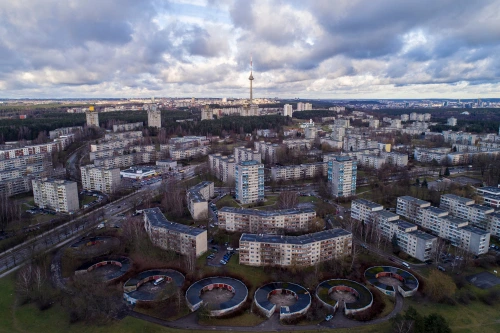
After the Second World War, the Soviet Union and its satellite states faced a housing crisis on a large scale. The urban destruction caused by the war, and the relocation of vast numbers of people to the cities due to rapid industrialisation, had led to overcrowding and housing conditions similar to those experienced in Victorian England.

In the second half of the 1950s, the Communist party set about solving the problem by producing vast quantities of housing, mostly made of prefabricated parts that could be easily mass-produced. The huge programme of post-war housing construction is both one of the Soviet bloc’s greatest successes and most iconic failures.
These new housing estates were called “microrayons” (literally micro-regions), and many had a population equivalent to entire cities in the West. Through these microrayons, governments in the Communist countries succeeded in providing nearly free housing for all workers. Rents were set at 5% of income (in the UK today we spend 26% of our income on rent). Citizens were provided with brand-new dwellings with central heating, hot water and electricity, which was unusual for the USSR at that time.
Some microrayons sum up everything that was lifeless, grey and oppressive about life under Communism: identical flats, on identical floors, in identical blocks, arranged around identical quads that stretched as far as the eye could see, crushed any sense of individualism. These new housing districts lacked identity, history, pride and place; everything that makes a collection of housing units located near each other into a community.
Despite being mass-produced by a centrally planned economy, there were substantial differences between microrayons. The Thousandth Anniversary Estate in Katowice, Poland, has visually distinct blocks, grass and wooded areas. Its most iconic building is the Corns, so named because its cylindrical structure resembles cobs of corn.
Beauty from a crisis
This microrayon is beautiful by contemporary standards of urban planning – partly because its green areas have grown up as the community grew, but also because EU funding has been used to restore the estate. Another example is Seskine in Vilnius, Lithuania, where variations in the prefabricated modernist architecture and locating the blocks around a central shopping square break up the uniformity of the microrayon.
But for every microrayon that expressed some individuality, there were others that were the epitome of how Communism was indifferent to the individual. These were designed from the top down and looked magnificent from above – but on the ground, they were impractical for living. Usachevka in Moscow was made from almost-identical three-to-five-storey square blocks. Built under Joseph Stalin, it is the epitome of a totalitarian housing development.
Lazdynai in Vilnius houses more than 30,000 people, but is entirely uniformly designed and consists of low-cost concrete-panel blocks of flats, known as Khrushchyovkas as they were the building choice of Nikita Khrushchev’s regime.
Estates like Lazdynai, designed in the International Style of modernist architecture, dominated the Warsaw Pact countries during the 1950s and ’60s. Stalin largely suppressed modernist architecture, as he did not want workers’ housing to be oppressive, uniform dwellings. The International Style was uniquely suited to the mass production of prefabricated parts, and this was the best way for Khrushchev’s centrally planned economy to produce enough housing to meet demand.
This quote from Czech writer Václav Havel sums up their approach: “It would be to the greatest advantage of a centrally-directed system of production if only one type of prefabricated panel were constructed, from which one type of apartment building would be constructed … and together this would create a single type of housing development constructed according to one standardized urban development plan, with minor adjustments for landscape, given the regrettable irregularity of the earth’s surface.”
The housing crisis that we face in the UK is very different to that of the post-war Soviet bloc. The Communist governments of Eastern Europe had an abundance of land to build on, which made housing developments on the scale of the microrayons possible. These countries were able to provide cheap housing for millions of people using centralised planning and mass production, but some microrayons were uniform to the point of being oppressive. Our capitalist system’s strength is in using different combinations of mass-produced goods to express our individualism, which does not lend itself to the construction of microrayons.
The microrayons show what can be achieved if a government has the will to tackle a housing crisis. We can learn from the mistakes of an over-reliance on mass production and prefabrication to create estates that are varied, pleasanter and more likely to foster vibrant communities.
This article draws heavily on the work of the architecture writer Owen Hatherley, particularly his book Landscapes of Communism and this article in the Architectural Review. We are happy to make this clear. To read more on this topic, check out Owen Hatherley’s book Landscapes of Communism, which you can buy online here.
[Read more: Most liveable city: How Vienna earned its place in housing history]






